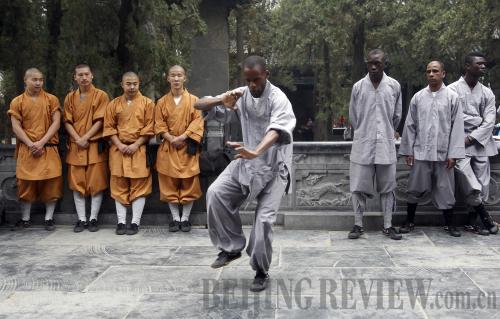|
 |
|
SHAOLIN STYLE: An African student performs a kungfu form as Chinese and African pupils look on at the famous Shaolin Temple in Henan Province (CFP) |
When a gray day dawned upon the sleeping Dengfeng City in Henan Province, a group of people were already well awake. After a short walk along the stone path, they soon gathered at an old temple. They pressed their palms together and bowed to their master, a Chinese monk in a yellow robe, who returned the courtesy.
The day's exercise began.
Among the early morning mist, the picturesque scene was like something out of a Chinese kungfu movie, except for the fact that all of the students were Africans.
The 20 students, from Tanzania, Ethiopia, Mauritius, Uganda and Nigeria, came to central China in September 2013. Over three months that followed, they were trained at the Shaolin Temple, the birthplace of Shaolin kungfu.
"With all this, my life will never remain the same," Ogwang Mark, a Ugandan, said about his Shaolin experience.
Work hard
The program Shaolin Kungfu Training Class for African Disciples was launched by the Chinese Ministry of Culture as part of the government's plan to further promote cultural exchange between China and Africa. The 20 "disciples" were selected from among the most outstanding martial arts practitioners in African countries, but the life in the Shaolin Temple was still an enormous challenge for each of them.
"I cried a lot in the first couple of days," said Peace Emezue, a 32-year-old Nigerian woman. In Nigeria, Emezue works as a fitness coach, and as a karate champion, she was selected for the program by the Nigerian Government in a bid to encourage women in Nigeria to take up martial arts.
Emezue was amused by the simple and peaceful life in the Shaolin Temple, but the tough training and early morning exercises were beyond imagining. She had to get up at 5:30 a.m. and kept practicing until 9 p.m. The routine went on six days a week for three months.
The word "kungfu" literally means "work hard," and people who work hard are described as having a lot of "kungfu." According to Abbot Shi Yongxin, the training program is too short for serious kungfu study, but the first three months are full of hardship for any practitioner.
The differences in weather and food posed more difficulties for African students. Wamala Peter from Uganda said that many students came down with colds when the winter came in November, "Even though [we became sick], our confidence and will were always strong, because the energetic and responsible instructors and masters have been helping us."
The training program also included a Chinese language course to help the Africans better understand the master's teaching. For most of the students, who came to China for the first time, learning Chinese was even more difficult than kungfu.
"I never thought of an opportunity to learn the Chinese language. It's really hard, but I will continue to learn it through the Internet when I'm back home," said Peter Zanang Kazah, a Nigerian karate practitioner.
When the program came to an end, most of the students had become well-adapted to life at Shaolin, which turned out to be quite rewarding. Some of them lost weight but gained a stronger constitution. During the graduation ceremony on December 18, the African students gave a kungfu performance to show what they had learned in the three months at the temple, which included classic fist routines and fighting techniques with swords and sticks as weapons.
| 